Jacqueline RAPPOPORT
THE END OF THE WAR:
Wartime campaigns, repression, deportation and the end of the Third Reich (1944-1945)
Convoy 77 – Biography of a deportee
Jacqueline Rappaport was born on September 24, 1924, and deported from Drancy on July 31, 1944 on Convoy n°77.
By Eléonore Cesari and Garance Girard,
12th grade students at the Henri-IV high school in Paris, France
Contents
-
Introduction to the Convoy 77 project
-
Jacqueline Rappoport’s biography
-
Family background
-
Childhood
-
During the war
-
Deportation
-
After the war
-
The UGIF children’s homes
-
The increase in deportation from Paris in the summer of 1944
-
Some invaluable records
-
Sources
The Convoy 77 project
The 77th deportation transport, known as “Convoy 77”, which left Paris on July 31, 1944, was the last of the major convoys of Jews to leave the Drancy internment camp for the Nazi extermination camp at Auschwitz-Birkenau. It included 1,310 men, women and children, many of whom had been rounded up when the Germans raided the UGIF children’s homes in and around Paris. According to the latest estimates, 836 of them killed in the gas chambers as soon as they arrived in Birkenau in early August, and only 93 men and 197 women survived.
This convoy, which left at a time when around a quarter of France had already been liberated, illustrates the increasingly hard-line German policy of anti-Jewish repression and the intensification of military operations in response to the Allied advance.
The aim of the Convoy 77 project is to reconstruct the life stories of each of the deportees, in order to better understand and raise awareness of the victims’ fate, and thus to further the survivors’ efforts by playing an active role in passing on the memory of the Holocaust.
Although more than half of the deportees were born in France, Convoy 77 was made up of deportees from 35 different countries, including some that were previously overlooked (such as Switzerland, United Kingdom, Cuba and Turkey). With people from a wide variety of backgrounds, Convoy 77 reflected the European, even international, scope of anti-Semitic persecution.
Convoy 77 is a European educational project that brings together students from across thirty-two different countries, enabling thousands of young Europeans to gain a better understanding of the Second World War and the Holocaust by taking part in an international memorial initiative.
Biography – Jacqueline Rappoport

Jacqueline Rappoport was born on September 24, 1924, at a quarter to one in the morning, at 83 boulevard de l’Hôpital in the 13th district of Paris, France.
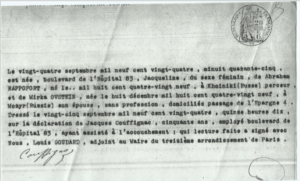
Jacqueline’s birth certificate, 1924
City of Paris Archives
Her family
Her father, Abraham Rappoport, then a drill operator, was born on May 28, 1889 in Khonniki, Russia.

Image: Shoah Memorial in Paris – MXII 23721
Her mother, Mirka Ovstein, was born in 1889 in Mozyr, Russia.

Image: Shoah Memorial in Paris – MXII 23722
Jacqueline was the youngest of four siblings. Her brother, Gaston, was born on August 17, 1912. Her sisters were Clara, born in 1913, and Berthe, born in 1918.
Her childhood
Jacqueline’s first home was at 4 passage de l’Épargne, in the 19th district of Paris. A dark, damp, impoverished cul-de-sac that no longer exists. Her parents, who had migrated to France from Russia, were clearly very poor folk.
Abraham and Mirka were married in Paris on November 16, 1929. This made their children “legitimate”. At this point, Jacqueline became a French citizen by naturalization.
According to the 1931 census, the family was by then living in the 20th district, at 140 rue de Ménilmontant. Abraham was a metalworker, Gaston was a furrier and Clara was an office worker.
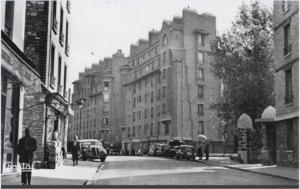
The building at 140 rue de Ménilmontant in the 20th district of Paris
By the time of the 1936 census, Gaston was a clock salesman, while Berthe and Clara worked for the Crédit du Nord bank. Their father, Abraham, was still a metalworker.
During the war
During the war, Jacqueline was in her early twenties and a student. She was taking classes on rue Vauquelin, and stated that she lived at 31 rue de Montevideo in the 16th district. This was in fact a synagogue, which is now called the Ohel Abraham Synagogue.
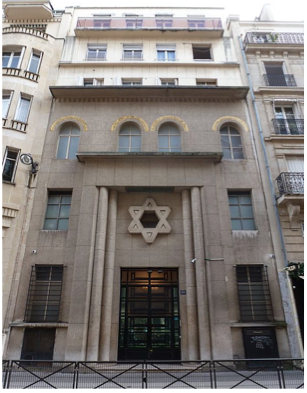
The Ohel Abraham synagogue was at one time home to a Jewish community, the Société de culte traditionnel israélite (Society for Traditional Jewish Worship), which was founded by Rabbi Simon Langer in 1893. Jacqueline no doubt stayed there.
His father and mother, Abraham and Mirka Rappoport, were deported on Convoy 9, which left Drancy for Auschwitz on July 22, 1942.
She also worked at unit no. 49 at the Secrétan school, at 70 avenue Secrétan in the 19th district of Paris, and at the Vauquelin school, on rue Vauquelin in the 5th district. These were children’s centers run by the UGIF (Union générale des Israélites de France or General Union of French Jews), and Jacqueline helped out at both.
Jacqueline was arrested on July 23, 1944. Her deportee’s record card states that she was arrested by German police while “in a group of Jewish children”. Another record says that she was distributing “anti-German papers”.
She was taken to the Drancy transit camp, where she was held for a week along with the other children, including some babies.
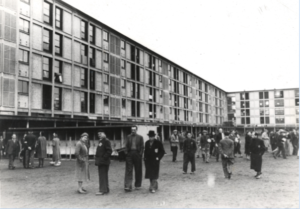
Drancy camp in 1944
Deportation
On July 31, 1944, Jacqueline was deported from Drancy to Auschwitz-Birkenau on Convoy 77.

The entrance to Auschwitz camp, in Poland
On August 3, 1944, the train arrived in Auschwitz. 847 people were sent straight to the gas chambers, where they were murdered. Jacqueline, together with 183 other women, was selected to go into the camp to perform forced labor.
In November 1944, a large number of women, including Jacqueline, were selected to be sent to Weisskirchen-Kratzau near Dresden in Czechoslovakia. The town is now called Chrastava. The women worked there in a weapons factory.
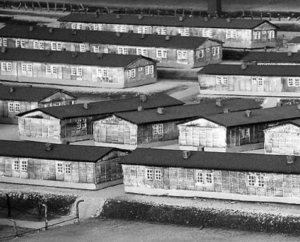
The Weisskirchen-Kratzau camp in what is now the Czech Republic
After the war
The Kratzau camp was liberated the day after the Armistice, on May 9, 1945. Jacqueline was repatriated to France on July 13, 1945, first arriving in Nancy. She reached Paris on July 14 and initially stayed at the Lutetia Hotel, at 23 rue de Sèvres. This was an assembly point for Jews who had returned from the camps.
After the war, in 1948, Jacqueline married a man by the name of Davies. She then became a British citizen by marriage, and settled in Wales with her husband. They lived at Cliff House in Ferryside, in Carmarthenshire.
In 1962, she applied to the French Ministry of Veterans and Victims of War for the status of political deportee, which she was granted after sending in numerous supporting documents. In fact, she had lost her repatriation card that was issued just after the war (n°392990293), and therefore had to submit additional documents. On June 25, 1962, her political deportee card, n°219928689, was issued.
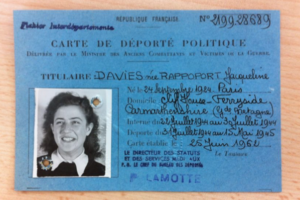
Jacqueline Davies’ deported person’s card – Victims of Contemporary Conflicts Archives Division of the Ministry of Defense Historical Service, in Caen – 21 P 629640
After that, there is no further trace of Jacqueline. In Paris, a search for people with the same name proved fruitless. The name Davies is very common in Great Britain, and we were unable to obtain any further information from Ferryside. Nor is there any information about her siblings, who appear to have avoided being deported. A letter dated 1962, signed B. Rappoport, Jacqueline’s sister, tells us only that Berthe was still alive at the time.
Did Jacqueline have any children? Did she leave Carmarthenshire and go into retirement somewhere else? Might she have returned to France, perhaps to Paris? Is she still alive? We have no way of knowing, so we imagine, we hope, that she lived a happy and fulfilled life, despite everything she went through. For Jacqueline was a survivor, caught up in the Nazi killing frenzy, snatched from death, freed from her persecutors who wanted to deny her humanity, simply because she was born Jewish.
The UGIF children’s homes
The UGIF, the General Union of French Jews, was an organization founded by the Vichy government in France on November 29,1941. Its purpose was “to represent Jews in dealings with the public authorities, particularly in matters of welfare and social reassignment”.
As one of its official tasks was to provide assistance, it was entrusted with the care of Jewish children whose parents had been arrested, in particular from 1944 onwards. To do this, the UGIF opened “children’s homes”, and vocational schools where teenagers lived on site. These homes were supervised by the Commissariat Général aux Questions Juives (General Commission for Jewish Affairs) and the Gestapo. Many were placed there by their families, having been orphaned and left alone. Some were French, others were foreign citizens. However, although these children were given shelter, they were also registered by the Nazis, who listed them as “blocked children”, meaning that they were liable to be deported at any moment.
In 1942, after a series of roundups, the UGIF opened a number of homes and schools in Paris and the surrounding area, including those on rue Lamarck, rue Vauquelin and rue des Rosiers, as well as those in Louveciennes, La Varenne, Montreuil, Neuilly and Saint-Mandé.
In April 1944, when the Lamarck home was damaged by bombing, the Lucien-de-Hirsch Jewish school building at 70 avenue Secrétan became a reception center. Jacqueline worked there, as well as at the home on rue Vauquelin. She was registered with the UGIF and looked after young Jewish children.
In July 1944, three weeks before Paris was liberated, SS man Alois Brunner ordered a series of raids on these children’s homes in and around Paris. Over 300 children, including 18 babies and 217 aged from 1 to 14, were arrested and taken to the Drancy transit camp. Some adults, including teachers and supervisors, were taken with them. Among them were the 20 little girls from the Saint-Mandé orphanage and the manager, Thérèse Cahen, who went with them to the gas chamber. Jacqueline was one of the adults who were arrested. All of them were deported to Auschwitz on Convoy 77 on July 31, 1944.
The increase in deportations in the summer of 1944
The summer of 1944 marked a turning point in the Reich regime’s repression in Western Europe. As Allied campaigns were launched, such as Operation Overlord on June 6, 1944 and Operation Bagration on June 22, 1944, and the troops advanced to liberate the occupied areas, the Germans concentrated their efforts on their war of annihilation of the Jews.
The “Final Solution to the Jewish Question”, which had been planned at the Wannsee conference in January 1942, had become a key element of Nazi policy. Before the Germans left the occupied areas, which had become increasingly hostile as the Allies gained ground, they were determined to eradicate the Jewish people at all costs. Jews, like resistance fighters, were deemed to be responsible for a possible defeat, and the level of brutality reached new heights as the Third Reich was nearing the end. Far from representing an ebbing of the tide, 1944 saw an increase in Nazi repression and barbarism, right up until the last few days before France was liberated.
The killing of prisoners was speeded up, and massive numbers of people were deported to the East. In France, increasing numbers of convoys left the prisons and camps, even as bombing and sabotage intensified, hampering the transports. Carried away by their insane extermination drive, the Germans neglected their military strategy and security, even to the point of prioritizing the deportation convoys.
At the end of July 1944, the situation became highly volatile. In addition to the Allied advance, an assassination attempt on Hitler’s life and a failed putsch attempt on July 20 led to great confusion. In Paris, one man took advantage of the Reich’s unbridled anger to pursue his murderous killing spree to the bitter end.
Alois Brunner, the commandant of Drancy camp, gave the order for the UGIF houses in and around Paris to be raided, as they were full of Jewish children who had been identified by the Nazis. 350 children were rounded up, including 18 babies and 250 others under the age of 14, as well as UGIF managers and staff. On July 31, 1944, they were all loaded onto Convoy 77, bound for Auschwitz. This was one of the last large convoys to leave France for the death camps. Of the 1,310 deportees, 836 were killed in the gas chambers as soon as they arrived. Only 250 survived the forced labor, hunger, disease, pseudo-medical experiments, the deprivation of the end of the war and the Death Marches… Only 250 men and women who were deported on Convoy 77 survived the hell of the Nazi barbarism.
Some invaluable records
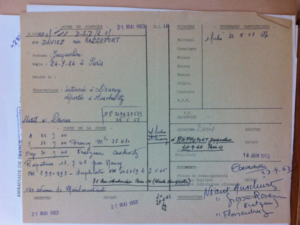

Record sheets from the Auschwitz archives
Victims of Contemporary Conflicts Archives Division of the Ministry of Defense Historical Service, in Caen, ref: 21 P 629640

Various records
Victims of Contemporary Conflicts Archives Division of the Ministry of Defense Historical Service, in Caen, ref: 21 P 629640



Application form for the status of deportee
Victims of Contemporary Conflicts Archives Division of the Ministry of Defense Historical Service, in Caen, ref: 21 P 629640
Paris city archives

A page from the 1936 census of the 20th district of Paris
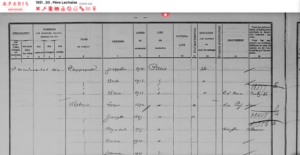
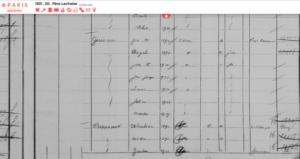
Pages from the 1931 census of the 20th district of Paris
Sources – Biography
Archives provided by the Convoy 77 project team:
- Victims of Contemporary Conflicts Archives Division of the Ministry of Defense Historical Service, in Caen, France:
Victims of Contemporary Conflicts Archives Division of the Ministry of Defense, Office for deportees and miscellaneous statuses.
Archives grouped under reference 21 P 629640, dating from 1962.
Letters from Jacqueline to the Ministry
Lost political deportee card dossier
Application for the status of deportee
Political deportee card
- The Shoah Memorial in Paris :
Undated summary report on the activities of the UGIF (“General Union of French Jews”), drawn up under the chairmanship of Georges Edinger – CCCLXXIX-33
Drancy file – FRAN107_F_9_5722_211769_L
Also:
- Records from Paris City Hall:
1936 census of the 20th district of Paris, Père Lachaise district D2M 8704
1931 census of the 20th district of Paris, D2M 8462
Paris electoral register, D4M 756
- Images :
70bb72fda4a88aea1db6222b5d57c972.jpg
800px-Synagogue_Ohel_Abraham_façade.jpg
2015-05-06-1430920907-1458202-SilencedWalls1.JPG
auschwitz.jpg
- Sources – Further research
70bb72fda4a88aea1db6222b5d57c972.jpg
800px-Synagogue_Ohel_Abraham_façade.jpg
2015-05-06-1430920907-1458202-SilencedWalls1.JPG
auschwitz.jpg
- Sources – Recherches complémentaires
Brochure for the French National Resistance and Deportation Competition – The end of the war – 2022
Convoy 77 website
Wikipedia – Convoy n°77
Wikipedia – The roundup of the children’s home on Avenue Secrétan
Wikipedia – The Lucien-de-Hirsch school


 Français
Français Polski
Polski










